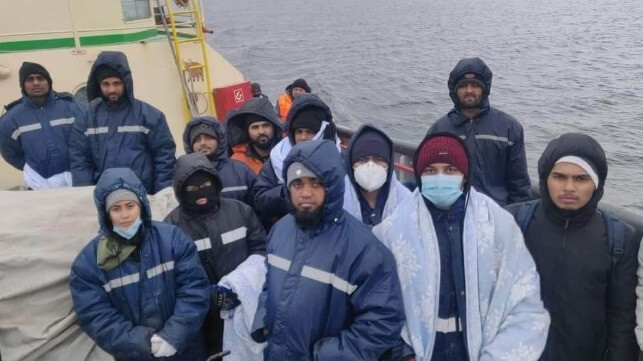ICS: 500 Seafarers Aboard 100 Ships Remain Trapped in Ukraine

More than two months after the invasion of Ukraine, the International Chamber of Shipping reports that while there has been progress that a significant number of seafarers and vessels remain trapped and in danger. Working with the United Nations, the ICS prepared data illustrating the danger while also renewing calls for actions to facilitate the evacuation of the remaining seafarers.
The ICS calculates that approximately 500 seafarers remain trapped on vessels stuck in Ukrainian ports. They believe that as many as three-quarters of seafarers have now been evacuated from their vessels. The ICS commended the rescue effort taken by flag states, port states, and labor supply states, as well as governments, shipowners, unions, international aid agencies, and seafarer charities.
“While we are relieved that around 1,500 have been successfully evacuated, our focus is on those still onboard,” said Natalie Shaw, director of employment affairs at ICS. “We will continue to do all we can to facilitate their safe passage out of the affected areas and, in the meantime, work with aid agencies to ensure the delivery of humanitarian aid to those still affected.”
A month into the conflict, the ICS reported that it believed there were 2,000 seafarers aboard ships trapped at Ukrainian ports in the Black Sea and the Sea of Azov. They point to the success of removing many of those seafarers while highlighting that skeleton crews remain aboard many ships. The urgency has increased as Russia continues to bombard many of the seaports. Further, while it only confirmed what was already happening, Ukraine’s Ministry of Infrastructure also issued a new order this week to keep the seaports of Mariupol, Kherson, Berdiansk, and Skadovsk closed, “until Ukraine regains control over them.”
The ICS calculates that 74 or more vessels are stuck in or near the major seaports of Mykolaiv (25), Chornomorsk (23), Kherson (16), and Odesa (10). They report that actual numbers might vary because some ships have turned off their AIS. In addition, there are smaller numbers of ships at local ports including Berdyansk (8), Pivdennyi (6), Mariupol (5), Nika Tera (2), Ochakiv (2), Izmail (1), and Yuzhny anchorage (1).
The majority of the vessels are either bulk carriers or cargo ships with the ICS estimating the number ranging between a low of 99 and possibly 109. Other vessels include oil tankers, chemical tankers, tugs, ro-ro cargo, an ice-breaker, and motor hoppers.
Many of the seafarers have been able to reach evacuation flights or board buses from the ports but others they caution remain in Ukraine waiting for evacuation and repatriation. In addition, they highlight that fellow seafarers stayed behind as skeleton crews to maintain the ships while permitting their fellow crew mates to escape.
While the International Labour Organization (ILO), the IMO, UNHCR and humanitarian organizations have coordinated deliveries of food, water, and medicines to the remaining crew, the ICS cautions that not all of the supplies are making it to the seafarers. The affected seafarers, both the evacuated and those who remain onboard, are from 27 different countries, with the largest number from the Philippines and India. Other affected seafarer nationalities include Ukrainian, Russian, Chinese, Danish, Greek, and Turkish.
The ICS, along with the UN Secretary-General, continues to urge the creation and preservation of humanitarian corridors, until all remaining seafarers have been safely evacuated.
